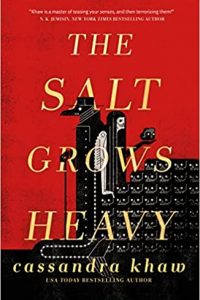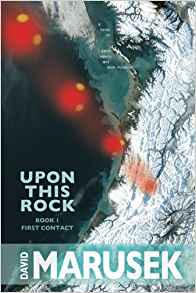Cynthia Ward reviews Melissa Scott & Lisa A. Barnett
 The season of rising summer has come to Astreiant, throne-city of the queendom of Chenedolle. The winter-sun shines until midnight, the Midsummer Fair will soon begin, and the merchants are hiring for journeys to the Silklands, the League, and other queendoms. In short, it’s the time unhappy adolescents run away in search of a better life.
The season of rising summer has come to Astreiant, throne-city of the queendom of Chenedolle. The winter-sun shines until midnight, the Midsummer Fair will soon begin, and the merchants are hiring for journeys to the Silklands, the League, and other queendoms. In short, it’s the time unhappy adolescents run away in search of a better life.
Just another normal fair season, thinks Nicholas Rathe, a low-born, scrupulously honest Adjunct Point (police sergeant) assigned to the city district known as Point of Hopes. Then he’s asked by a prosperous guildsman to investigate the disappearance of his apprentice. The butcher’s guild is powerful and desirable; and the missing girl was well treated, well trained, and well liked, with a girlfriend in the same business. She had no discernible reason to flee.
When Rathe reports the disappearance to his boss, Chief Point Monteia, she tells him children are inexplicably disappearing from all social classes and all parts of the city. But they’re not being killed; the necromancers aren’t finding the missing children’s ghosts. With no other leads, they seek a University astrologer to cast horoscopes for the missing children and look for a relationship among their natal stars; and Rathe investigates Hanselin Caiazzo, a wealthy, powerful crime lord who has begun acting oddly. He expands his list of suspects when he hears about a new group of freelance astrologers selling horoscopes at cut-rate prices.
Elsewhere in Astreiant, a sharp-looking and sharp-witted foreign soldier, Philip Eslingen, is mustered out of a disbanding mercenary company with little hope of new employment. However, when he expertly defuses a tavern brawl, he gains a job as a security guard and attracts the suspicion of the butchers’ guild. With tensions mounting in Astreiant over the increasing number of disappearing children and the continuing failure of the childless queen to name an heiress, the butchers attack. Arrested for killing one of his assailants, Eslingen loses his job and finds himself working for the crime lord–as an informant for Adjunct Point Rathe.
In the immemorial tradition of buddy fiction, the disheveled pointsman, who has minimal interest in astrology or yellow journalism, and the image-conscious ex-soldier, who is attentive to the stars and broadsheets, have little in common beyond low-caste origins and a strong drive to find the missing children. But, as they work together with unexpected ease and increasing mutual interest, Rathe and Eslingen uncover the strange link which unites the missing children with the mysterious new astrologers; the factional struggle to replace the queen; the crime lord’s suspicious behavior; and a source of alchemically potent gold. That link will allow a very powerful, very dangerous alchemist to control of the stars themselves, if Rathe and Eslingen can’t stop him.
If the above description of Point of Hopes–the classic police-procedural fantasy novel written by Melissa Scott and the late Lisa A. Barnett, originally published in 1995 and newly reissued by Lethe Press–seems to indicate just another Euro-medievaloid “magic-works” setting, I’ve done the book a grave disservice. Yet the novel’s complex fictional world is not easily summarized. Consider these descriptions of the Astreiant series that I’ve heard over the past near-two decades: The city of Astreiant is located in an alternate Earth. It’s medieval. It’s Elizabethan. It’s based on Renaissance Italy. It’s based on the Dutch Golden Age. It’s based on Renaissance France. It’s queer. Its characters are all bisexual. Its characters are persons of color. Its characters are white. Its society is egalitarian.
This is what I know, or think I know. Astreiant is located on a secondary world where astrology, alchemy, necromancy, and other forms of magic are working sciences; but, despite the many echoes of our Renaissance Era, this is no alternate history. It’s not even an alternate Earth. Earth never had two suns. Earth never had a year as long as Astreiant’s. Earth never enjoyed a Renaissance which featured sexually fluid, racially diverse, polytheistic, matrilineal, matriarchal nations.
Like our world, Astreiant’s has inequities of class and wealth, and the power structures are generally dominated by one sex. And, while Astreint’s “levelers” pursue a political philosophy aimed at eliminating socioeconomic inequity, the city’s inhabitants don’t think to question the inequality of the sexes. Yet neither is anyone upset to find a man in a “woman’s role” or a woman in a “man’s role.” And, while heterosexual marriage exists to handle matters of business and inheritance, gender is so thoroughly disconnected from sexual behavior, this world has no terms equivalent to our multitudinous descriptors for straight, gay, and bisexual individuals and relationships. Too, wars are fought and nationality is important, but no one assigns any significance to differences in skin color. In other words, life on the world of Astreiant generally has little to do with epidermal tones or body parts. Instead, a person’s life–the broad outlines, though not the details, of her personality, looks, profession, and death–is determined by the positions of the stars under which she was born.
Astrology as destiny! It’s not just an inspired choice for creating a fantasy world which differs significantly from our own. It’s not just a brilliant method for devising a crime and motives that can’t exist in our world. It’s an approach that casts a tremendously revealing light on our own beliefs, behaviors, and perceptions.
To be sure, this form of alchemy hasn’t power enough to shake the stars. But, in the skilled hands of Melissa Scott and Lisa A. Barnett, it’s power enough to reshape your perceptions of gender, race, and biology. And it’s power enough to make you finish Point of Hopes eager to dive immediately into sequels. Fortunately, two subsequent volumes in the Astreiant series–Point of Knives (new in 2012) by Scott and Point of Dreams (originally published in 2001) by Scott and Barnett–are newly available in matching editions from Lethe Press; and a new follow-up volume, Scott’s Fair’s Point, is forthcoming in 2013.







